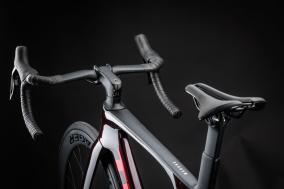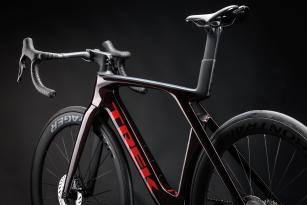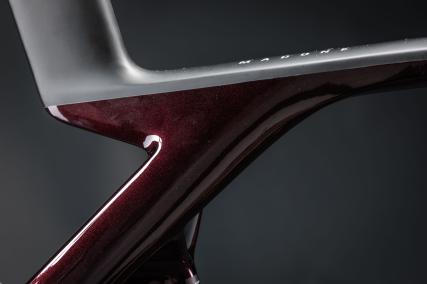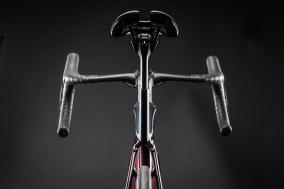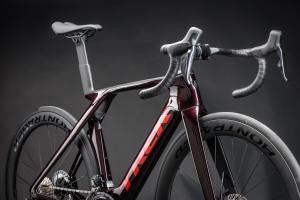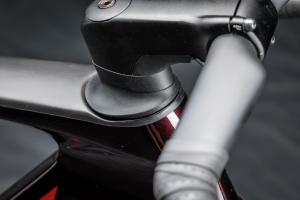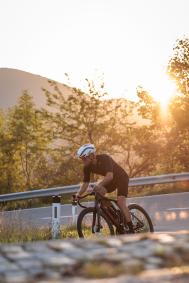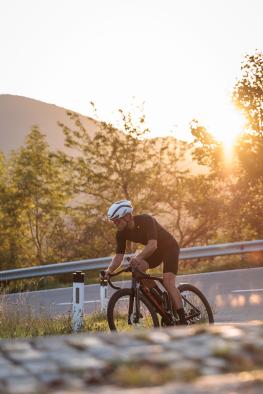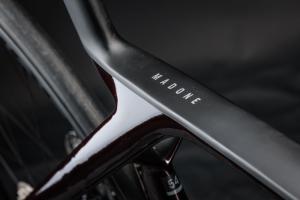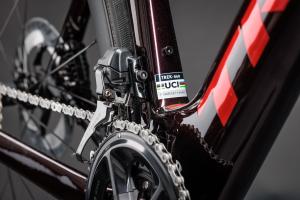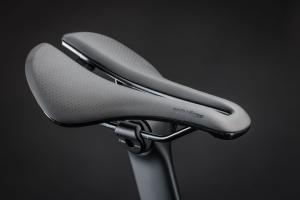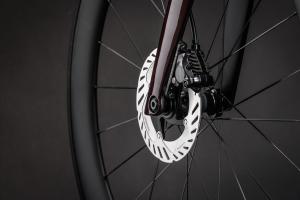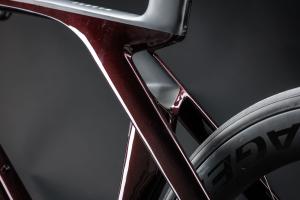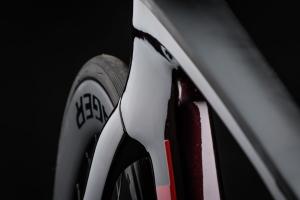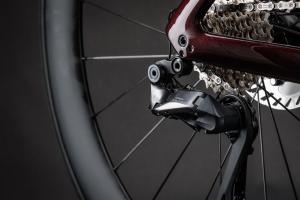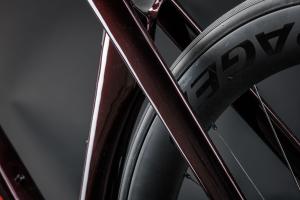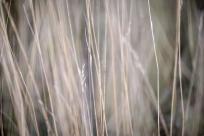
Trek Madone SL Gen 7 Showroom + First Ride
05.09.23 07:46 3212023-09-05T07:46:00+02:00Text: NoPain (translated by AI)Photos: Erwin HaidenWith the new Madone SL, Trek rounds off its Madone Gen 7 series and, thanks to this more affordable option, allows even more people access to the exclusive IsoFlow technology for improved aerodynamics and increased riding comfort.05.09.23 07:46 5672023-09-05T07:46:00+02:00Trek Madone SL Gen 7 Showroom + First Ride
05.09.23 07:46 5672023-09-05T07:46:00+02:00 NoPain (translated by AI) Erwin HaidenWith the new Madone SL, Trek rounds off its Madone Gen 7 series and, thanks to this more affordable option, allows even more people access to the exclusive IsoFlow technology for improved aerodynamics and increased riding comfort.05.09.23 07:46 5672023-09-05T07:46:00+02:00About a year after the presentation of their polarizing Trek Madone SLR Gen 7 racing bike, the Americans are finally releasing the long-awaited SL version. From an aesthetic standpoint, the design shows hardly any differences. Since the technical deviations are also rather subtle, the performance in terms of aerodynamics and comfort should reach a comparably high level – and at a slightly more affordable purchase price.
But what exactly differentiates the SL Gen 7 from the SLR, or its predecessor, the SL Gen 6? Overall, the SL models are more affordable but also heavier than the top version due to the slightly heavier frame material made of 500 series OCLV Carbon and the two-piece combination of the flared Bontrager RSL handlebar and the Bontrager RCS Pro stem. However, a positive perspective could be that the heavier composite might increase durability – though this has not been officially confirmed by Trek.
Regardless, the new Madone SL Gen 7 is about 300 grams lighter due to its optimized construction and enables an impressive time saving of 54 seconds at a speed of 45 km/h per hour compared to the previous generation.
Astonishingly light, excitingly fast, remarkably comfortable, and extraordinarily aerodynamic.
Trek on its Madone SL - apart from the claim "astonishingly light," we agree.Bontrager RSL Aero Handlebar + Trek RCS Pro Stem
The most obvious difference to the SLR is the two-piece combo of the Bontrager RSL Aero handlebar with the RCS Pro stem. Unlike the one-piece cockpit of the SLR, here the brake lines are visible below the handlebar up to the opening at the bottom of the stem.
Apart from the fact that everything has been resolved visually cleanly, the two-piece combo facilitates ergonomic adjustment - not to mention the practical advantage that the racing bike can be stored much more easily when shipping or packing for air travel.
Ergonomics is also a big priority with the RSL Aero handlebar. Thus, all carbon handlebars have a slight flare of 30 millimeters.
In the frame size 54, the width at the brake levers is 390 millimeters and that at the lower handlebar the stated 420 millimeters. This allows for a more comfortable seating position with improved aerodynamics and total control.
Treks exclusive IsoFlow technology
Trek introduces with its IsoFlow technology, namely the distinctive cutout beneath the seat tube, which was specially developed for the 7th generation Madone, two essential aspects into play: On one hand, the Americans promise improved aerodynamics, on the other hand, more comfort.
While the aerodynamic performance is difficult to verify without a wind tunnel, comfort is a noticeable factor. Undoubtedly, the frame opening, along with the other components, seems to support vertical compliance, but it also brings a significant disadvantage: The seatpost, which is available in two lengths, each has an adjustment range of a modest 7 cm downwards or upwards.
In other words: With both seat masts, a maximum adjustment range of a total of 10 centimeters is possible. This should be considered before purchasing, because, of course, only one mast is included.
I received the review bike in frame size 54 with the shorter version, which ultimately proved to be a tad "too short". With the specified "Max. seat stay height (with short seat mast)" of 70.5 cm (bottom bracket center to seat stay center) I was missing around 5 mm to my comfortable height of 74 cm (bottom bracket center to saddle top).
Although fitting gravel pedals temporarily fixed the problem, if it were my bike, I would have had to purchase the long seat mast.
Trek explicitly emphasizes that no carbon grease needs to be used on the post. We adhered to this and had no problems with stability or annoying noises.
The clamping system also seems to be firmly integrated into the seat post, which significantly increases its suitability for everyday use during repairs or travel. Thanks to the easily accessible 4mm Allen clamp screw, good adjustability on the go is also ensured - even with fiddly multitools.
Equipment
The Trek Madone SL Gen 7 uses solid 500 series OCLV Carbon for the frame and features noticeably high lateral stiffness, especially in the bottom bracket area.
For the bottom bracket, just like with the SLR, the screw-in Praxis Shimano T47 Inboard BB is used. With a width of 85.5 mm, the T47 bottom bracket is considered reliable, easy to handle, and is compatible with Shimano 24 mm cranks.
Shimano's complete Ultegra Di2 setup is beyond reproach and even has performance-oriented chainring sizes with 52/36 teeth. In addition, the crank length increases with the frame sizes. Very nice!
The Madone SL 7 is delivered with Bontrager R3 Hard-Case Lite road bike tires in 25C with tubes, which pleases me as a TLR-refuser on road bikes. On the other hand, it could potentially upset tubeless fans, as the inexpensive OEM tires are not TLR-capable, while the Bontrager Aeolus Pro 51 wheels with an inner width of 23 millimeters could indeed be ridden tubeless.
For a switch, the user would thus need TLR valves, TLR-capable tires, and a suitable tire sealant, as well as possibly also TLR-capable rim tapes - however, we did not verify this.
Tech Specs SL 7 Gen 7
| Frame | 500 Series OCLV Carbon, KVF tube profile, IsoFlow seat tube, internal cable routing, 3S chain guide, 142 x 12 mm thru-axle | Fork | Madone KVF Full Carbon, tapered, internal brake cable routing, Flatmount Disc, Carbon dropouts, 12x100 mm thru-axle |
| Sizes | 47/50/52/54/56/58/60/62 | Shift levers | Shimano Ultegra R8170 Di2, 12-speed |
| Front derailleur | Shimano Ultegra R8150 Di2, braze-on version, Down Swing | Rear derailleur | Shimano Ultegra R8150 Di2, 34T max cog |
| Crank | Shimano Ultegra R8100, 52/36, 172.5 mm (Size 54) | Bottom bracket | Praxis, T47, threaded, internally mounted |
| Cassette | Shimano Ultegra R8100, 11-30, 12-speed | Chain | Shimano XT M8100, 12-speed |
| Front wheel | Bontrager Aeolus Pro 51, OCLV Carbon, Tubeless Ready, 100 x 12 mm thru-axle | Rear wheel | Bontrager Aeolus Pro 51, Tubeless Ready, 142 x 12 mm thru-axle |
| Tires | Bontrager R3 Hard-Case Lite, aramid bead core, 120 TPI, 25C | Max. tire size | 32 mm (see manual) |
| Saddle | Bontrager Aeolus Comp, steel rails, 145 mm width | Seatpost | Madone Aero Carbon seat mast, 0 mm offset, 2 lengths |
| Handlebar | Bontrager RSL Aero, OCLV Carbon, 31.8 mm, Di2 cable routing, 80 mm reach, 124 mm drop, 42 cm width (39/42 Flared) | Handlebar tape | Bontrager Supertack Perf. |
| Stem | Trek RCS Pro, -7 degrees, 90 mm | Brake discs | Shimano CL800, 160 mm |
| Weight | 8.04 kg (BB measurement) | Price (RRP) | € 7,999.00 |
Modern Performance Geometry
The Trek Madone SL 7 Gen 7 is a very sporty racing bike with the same race-focused H1.5 geometry that we already know from the SLR. In our eyes, it is still a versatile, albeit quite high-performance, compromise between high agility and good stability, with which both beginners in the group and experienced users when speeding should have their fun.
Geometry
| 47 | 50 | 52 | 54 | 56 | 58 | 60 | 62 | |
|---|---|---|---|---|---|---|---|---|
| Rec. Body Height (cm) | 152-158 | 158-163 | 163-168 | 168-174 | 174-180 | 180-185 | 185-190 | 190-195 |
| Rec. Inseam Length (cm) | 71-75 | 74- 77 | 76- 79 | 78- 82 | 81-85 | 84-87 | 86-90 | 89-92 |
| Seat Tube (mm) | 424 | 453 | 483 | 496 | 525 | 553 | 573 | 573 |
| Seat Tube Angle (°) | 74.6° | 74.6° | 74.2° | 73.7° | 73.3° | 73.0° | 72.8° | 72.5° |
| Head Tube Length incl. Headset Cover (mm) | 100 | 111 | 121 | 131 | 151 | 171 | 191 | 211 |
| Steering Angle (°) | 72.1° | 72.1° | 72.8° | 73.0° | 73.5° | 73.8° | 73.9° | 73.9° |
| Effective Top Tube (mm) | 512 | 512 | 534 | 543 | 559 | 574 | 586 | 598 |
| Bottom Bracket Drop (mm) | 72 | 72 | 72 | 70 | 70 | 68 | 68 | 68 |
| Chainstay Length (mm) | 410 | 410 | 410 | 410 | 410 | 411 | 411 | 412 |
| Fork Offset (mm) | 45 | 45 | 45 | 45 | 40 | 40 | 40 | 40 |
| Trail (mm) | 68 | 62 | 58 | 56 | 58 | 57 | 56 | 56 |
| Wheelbase (mm) | 972 | 974 | 977 | 981 | 983 | 992 | 1,001 | 1,010 |
| Stack (mm) | 507 | 521 | 533 | 541 | 563 | 581 | 601 | 620 |
| Reach (mm) | 373 | 378 | 383 | 386 | 391 | 396 | 399 | 403 |
| Stem Length (mm) | 80 | 90 | 90 | 90 | 100 | 100 | 110 | 110 |
Models and Prices
From the Madone SL, only two models with Shimano 105 Di2 or Ultegra Di2 are offered. Additionally, it is worth mentioning that the framesets are exclusively compatible with electronic groupsets.
Moreover, Trek also offers the Madone SL 7 as a frame set for 3,999 euros. The weight is said to be 1,200 grams for the painted frame and 476 grams for the painted fork in size 56.
First Riding Impressions
Despite its sporty genes, the Trek Madone SL 7 Gen 7 is undoubtedly comfortable and effectively dampens even larger road irregularities. If that's still not enough, one could switch to smoother tires or convert to tubeless.
We found its handling in curves to be responsive, yet always stable both at high speeds and in slow, tight turns.
Of course, the Madone SL also allows for a particularly fast riding style; at least on flat terrain or downhill. Because with its weight of 8.04 kg, it is truly not ultra-light, which one might feel compared to the SLR or other aerodynamically optimized lightweight all-rounders, during rapid changes of pace or even downhill.
In the case of NoPain, however, it's anyway "casting pearls before swine". But that's another story ...
Pearls before swine.
The Madone SL 7 Gen 7 in the case of NoPain| Bontrager RSL Aero Handlebar + Trek RCS Pro Stem |
| Treks exclusive IsoFlow technology |
| Equipment |
| Tech Specs SL 7 Gen 7 |
| Modern Performance Geometry |
| Geometry |
| Models and Prices |
| First Riding Impressions |
| Links |






















